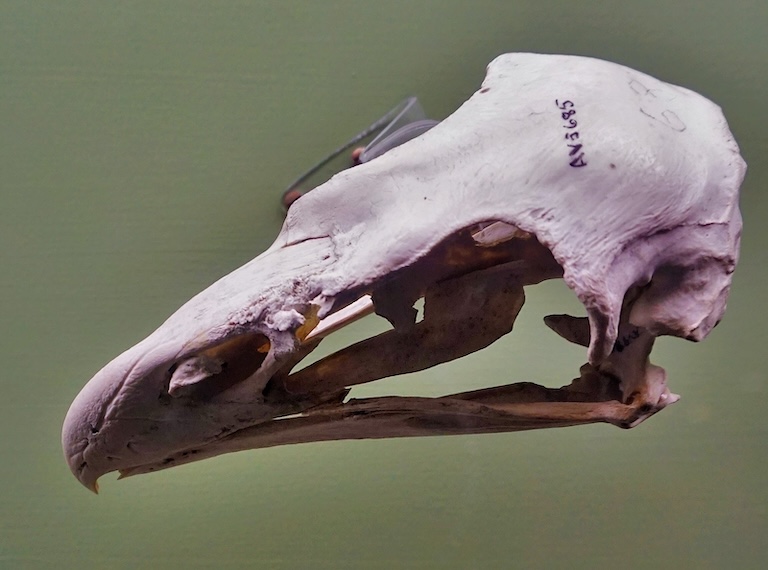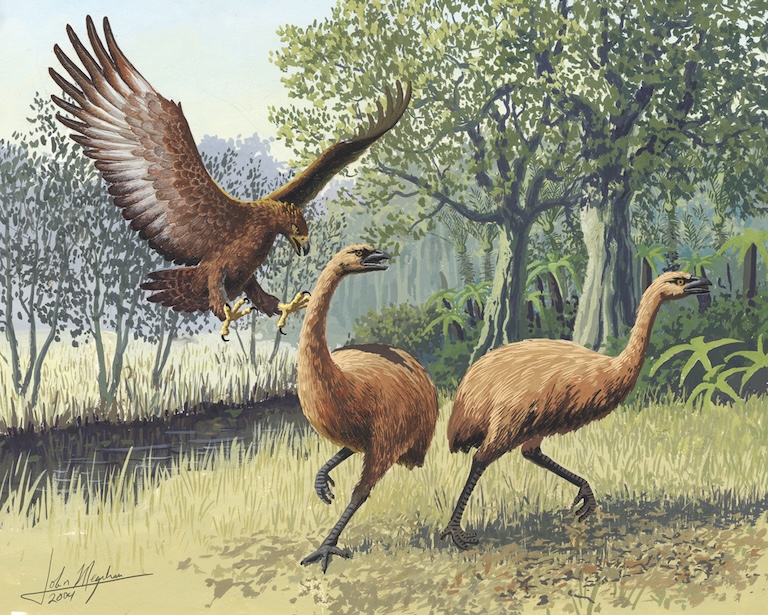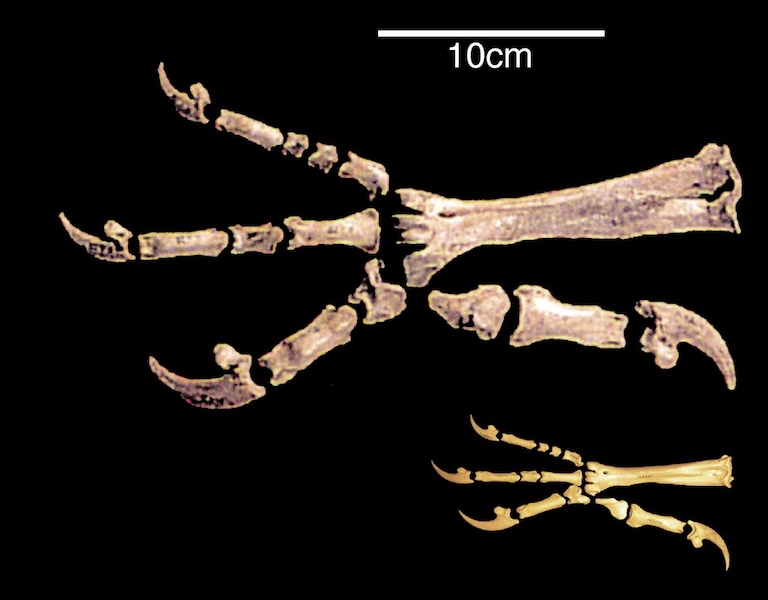Haast’s Eagle Profile
Old Māori legend speaks of the “Old gluttonous one”; a monstrous bird that eats humans. It’s depicted as larger than any extant eagle, with wings that could block out the sun, talons as long as spears, and a shriek that echoed for miles around.
It was said to have built its nest atop a mountain and dropped down now and again to grab men, women and children to feed to its ravenous young and to feast upon itself.
The legends say a man called Te Hau o Tawera, upon discovering a whole village of its cowering and useless victims, went all St George on the beast in exchange for some manuka saplings.
Unlike the legend of St George, though, there’s some evidence that this monster existed, and Sir Julius Von Haast was the first person to study its bones.

Haast’s Eagle Facts Overview
| Habitat: | Forests and shrubland |
| Location: | New Zealand |
| Lifespan: | Unknown |
| Size: | 1.4m long, (4.6 ft) Up to 3 metre (10 ft) wingspans |
| Weight: | Up to 18 kg |
| Colour: | Unknown, possibly red, black and white according to legends |
| Diet: | Moas, probably also geese, ducks, cowering villagers, etc |
| Predators: | Only humans |
| Top Speed: | Unknown |
| No. of Species: | 1 |
| Conservation Status: | Dead |
The legend continues, and there are some elements that make it particularly believable. For one, our hero Te Hau o Tawera didn’t actually kill the bird, but ran away in fear, luring it into a net surrounded by the 50 armed men he had brought with him.
Secondly, while now free from the tyranny of the monster, the villagers were soon wiped out by an invading tribe and replaced.
But also, the Haast’s eagle bones suggest a raptor more than twice as heavy as the largest eagles around today, and this alone is terrifyingly in line with the legend.
This was an eagle specialised in hunting a running bird twice as big as an ostrich. Thankfully, like we do with all animals we’re even remotely inconvenienced by: we killed them all.
Interesting Haast’s Eagle Facts
1. They were small eagles
The genus of the Haast’s eagle, Hieraaetus is still alive and well, and contains birds known as hawk-eagles, or, more commonly, “small” eagles. And they are small, mostly, or at least medium-sized, found all over the world.
The closest living relative of the Haast’s eagle is the so-called little eagle, which is ironically one of the smallest eagles around.
The ancestor of the Haast’s is thought to have diverged from that of its tiny sibling somewhere between 700,000 and 1.8 million years ago. And in that time, it managed to get decidedly not little.1

2. They were bloody big
This eagle was the largest predator around on the islands. It’s still the largest eagle species ever described and was also incredibly well-built.
Haast’s had a body weight of up to 18 kg, with a 13 cm beak and legs more akin to the heaviest vultures around today. It also had very large talons at around 8 cm in length and a body length of around 1.4 metres.
So, it had the body and wings of an eagle and the legs and beak of a vulture, but the size of a mythical beast, and if the hypotheses are correct, it attained this size in record time, possibly in just one million years.
Being enormous would have aided in surviving the multiple glacial periods New Zealand experienced in that time, and helped it with its major prey source. 2
3. They hunted moas
With no large mammals on the island, birds took over all the herbivory niches. The giant ostrich-like Moa would have been plentiful in the ancient forests of New Zealand and the Haast’s eagle would have evolved to specialise in killing them.
Moas could grow to 3.6 metres tall and weigh around 250 kg. Studies have suggested the eagle would have come down hard on the back of its prey from a perch or a high flight and ultimately crushed the victim’s head with its talons, pierced it with the beak, or attacked the thin neck.
Being far larger than the raptor could carry, the Haast’s would then have eaten it as a vulture eats carrion: from the ground.
A new study found that Haast’s eagle used its huge talons to topple one of the heaviest birds that ever lived before delivering the killing blow with its beak and then eating its insides like a vulture. 3
4. They had short wings
This animal’s puny, 3-metre wingspan is on par with some of the largest birds around today, but compared with its enormous mass of possibly up to 18 kg, this is a relatively short-winged bird, which gives us clues about how it might have lived.
While its ancestors would have used the wide surface area of enormous wings to soar on high, this eagle likely had reduced wings to help it hunt in crowded spaces. And this would have made it a terrifying foe.
5. They were unique predators
The Haast’s eagle is the only eagle known to have become an apex predator in a vast and complex ecosystem like this.
They would have been incredibly powerful, and moa bones are riddled with damage from their hunter, some reaching well into the pelvis with their long talons.
Combining the stealth of an owl, the agility of a goshawk, and the brute force of a vulture, this animal would have certainly been capable of killing people, too. But obviously, the opposite was even more true. 4

6. They’re not, any more
It’s easy to forget how recently humans arrived on New Zealand, and just how much human history has passed there in the last few hundred years.
Despite occupying most of the globe by 800 years ago, humans had somehow bypassed New Zealand entirely until around this time, but a lot has happened since then.
Some, including Haast himself, suggest that the Māori weren’t even the first to arrive on the island, though a lot of these hypotheses are sprinkled with the racism of the times, and seem to be supported more by politicians than anthropologists.
Regardless of who was first, human settlements appear dating from around 1300 BC and by around 1445, there was no more eagle.
There’s evidence of direct hunting by the Maori of the eagle, but likely far more damaging effects came from the rats that came with them and ate all their eggs. These same rats would likely have decimated moa populations in a similar fashion, as would have the humans who hunted them for food.
Having evolved its speciality in the absence of any large, terrestrial mammals, the eagle had grown accustomed to eating its enormous prey from the ground, like a vulture.
With the arrival of humans and their animals, this was no longer feasible. 5
Haast’s Eagle Fact-File Summary
Scientific Classification
| Kingdom: | Animalia |
| Phylum: | Chordata |
| Class: | Aves |
| Order: | Accipitriformes |
| Family: | Accipitridae |
| Genus: | Hieraaetus |
| Species: | moorei |
Fact Sources & References
- Michael Bunce (2005), “Ancient DNA Provides New Insights into the Evolutionary History of New Zealand’s Extinct Giant Eagle”, PubMed Central.
- Boyce Upholt (2022), “How a Giant Eagle Once Came to Dominate New Zealand”, Smithsonian Magazine.
- James Ashworth (2021), “The world’s largest eagle hunted unlike any other bird of prey”, Natural History Museum.
- “Haast’s eagle”, New Zealand Birds Online.
- Joseph Fossil “The extinction date of Haast’s eagle (Hieraaetus morrei) of New Zealand”, The Fossil Forum.
